|
One AJ-1 Savage Heavy attack aircraft from Composite Seven,
VC-7, flying low on the water depicts the climax of the squadron's secondary mission, aerial mining.

 |
The redeployment or rotation of the Heavy Attack squadrons from French Morocco back to the States
was according to a plan that was made by the Heavy Attack Wing-One, back in Virginia and later in Sanford, Fla.
The rotation plan had been negotiated with the French and of course it affected many people. For one thing the
date for us was 15 October and the manner in which it took place was dictated requiring all of our planes to depart
close together and it could not take place until we were sure that all of the planes in the relieving squadron
had departed from Loges in the Azores Islands headed for Port Lyautey.
Because the guide-lines were so specific, much attention was devoted in our squadron to get everything
ready. Every department had their own preparations to make, including the maintenance department. During the weekend
before our date of departure, the whole maintenance gang was working to finish checks and to get each aircraft
in top notch shape.
This included test flights by the Maintenance Officer, Sid Baney and myself, Hersch Pahl. I recall
that we were up on such a flight late in the PM for testing various things. As a climax to this effort, Sid and
I decided to do something to get the attention of the guys on the ground or those out on the near-by nine-hole
golf course. Of course it was stupid and unusual but before landing we made a pass over the field with the jet
engine running at full power and had shut down and feathered one of the big 4 bladed props and on one of our two
big Pratt & Whitney R-2800 engines. Yes, it was a thrill to do it, but it was not very smart because we were
depending on just the one engine for a generator and hydraulic pump. The jet engine did not have a hydraulic pump
or generator. We made our pass over the field so that it appeared that we had both "recips" shut down,
in fact that is what some observers thought. After making the low pass over the field we pulled up sharply to get
some altitude as we un-feathered the propeller and started the dead engine for a normal landing. It was OK as far
as safety was concerned but a lot of observers sure thought that we had both radial engines shut down and was doing
it all with just the jet engine running at 90% power. Little things like this served as a morale booster for the
maintenance gang that had been working throughout the weekend.
An AJ-1 Savage Test Hop
Late in our deployment while we were getting ready to return to the states, I was returning from
a test hop in one of our planes. This AJ was light on fuel and had an empty bomb bay. Coming down from altitude,
I flew the plane through a big lazy helical spiral. I was heading downhill and had plenty of speed so I maintained
positive acceleration all the way around. My third crewmember, or radioman, was all excited and asked, "Sir,
what we just did - did we do what I think we did? And why was I able to stand up normally without depending on
my safety harness?" The answer of course was positive acceleration, and then I did a couple more just for
fun.
Later I learned my radioman had to sound off to his buddies and soon the news came back to me that
I had been doing slow rolls with the AJ, which wasn't quite right. I was not exactly called on the carpet for an
explanation, but when "Rocky" Rockwell, our new Skipper and former fighter pilot heard about it, he was
amused and seemed to understand. In fact I believe that he had been doing the maneuver himself.
Many years later I must say that "young fighter pilots who have faith in their ability and in
their airplanes are bound to do things that are not too smart." For that reason I am bound to give the pilot
of this nonfeasance (improper performance) a poor grade in judgment.
Many other things had been going on to get us all set for the big moving day. One thing of interest
was the disassembly of Les Lampman's "Black Knight" Vincent Motorcycle and packing the various parts
away in boxes marked "Admin Files" just like they were 6 months earlier for the trip over to Port Lyautey.
Hersch Pahl was a passenger on Lampman's Black Knight, Motorcycle
for a sight seeing trip in eastern Morocco in '52. Photo by Lampman.
|
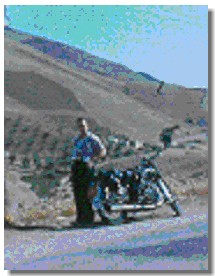
|
Les was our Landing Signal Officer (LSO) as well as one of the Admin Officers...

In the Photo above, Landing Signal (LSO) Lester Lampman is conducting field Carrier Landing practice
(FCLP) for an AJ-1 Savage early morning of the summer 1952 at Port Lyautey. Photo by Hersch Pahl.

Another item that needed special attention was the packing of a new Rudge bicycle (British) that
I had purchased for my oldest son, early in the summer at Gibraltar. The large space in the Bombay was being taken
by a big (rubber bag type) auxiliary fuel tank suspended from the bomb rack. We did not expect to use our jet engine
for this operation, so I carefully packed the bicycle in the plenum chamber or air inlet chamber for the Jet engine.
It was safe enough but it did take away the option of using the jet boost engine.
After Cdr. McConnell and his crew had been lost, the squadron was short of pilots for the return
trip. My Bombardier Navigator (BN), Don Jessen had been assigned as a co-pilot for one of the P2Vs. Also, the
BN for Carl Gieszl's AJ had been likewise assigned to pilot the P2V.
As I remember, we had an extra P2V to bring back to Norfolk. This made us two or three navigators
short. To fill this shortage, Carl Gieszl, the squadron Navigation Officer, selected a few volunteer enlisted men
to receive a crash course in day-light celestial navigation. These gents had been working diligently and had developed
a dependable skill in the use of a sextant and in using the sun to navigate for us on the way back across the Atlantic
to Norfolk, Va.
Other preparations
Before returning home, the new skipper, "Rocky" Rockwell indicated that he wanted all members
of the squadron to have the opportunity to make a trip to some other place in the area where they might do some
shopping before going home. For the most part, this meant that there would be a few short flights made to the English
shopping town on Gibraltar in the squadron's P2V.
Some of us had been to Tangiers before and this was not the place to take some of our crew to do
a little shopping. It is an international settlement located just across the straits south from the Rock of Gibraltar.
It is famous for its international Banks where we could usually get a pretty good rate of exchange trading "green
backs" for the various currencies that we needed when visiting other countries around the Mediterranean.
A transport plane that transported passengers from Tangiers
across the straits to the British field at the Rock of Gibraltar. This plane was found at the airport at Tangiers.
It ran a scheduled shuttle air service across the straits to Gibraltar. It was not the best way for our folks to
go shopping in Gibraltar. (Click image to download this picture)

|
|
VC-7 pilots visiting Tangiers. L-R: Charley Fritz, Sam Buchannan,
Sid Baney, and a North American technical representative (tech-rep), along with a native guide (body guard) which
they hired before going into town to do business at an International Bank and visiting other exotic places. (Click
image to download this picture)

|
|
The series of photo below show the approach to the famous Rock of Gibraltar from the Atlantic heading
to the north east. These three photos were taken by my copilot.



View of the Rock of Gibraltar as we made our approach to landing at the field located on the far
side of the rock near the Spanish border.

Early in our tour or deployment, Cdr. McConnell indicated that he wanted as many non-flying people
as possible, given the opportunity to go as part of the crew to other places in the Mediterranean area, when ever
a flight needed to be made on business. The Catholic men were given the opportunity to visit Rome and the Vatican.
Some even got to see the Pope during one of his routine appearances at St. Peters Cathedral. Others had the privilege
of going to Munich, German for the Oktoberfest, and to Oslo, Norway in honor of King Olaf's birthday.
Yet others made it to Lisbon, Portugal as passengers on a routine mail run. (The official mail for
the embassy at Lisbon came first to Port Lyautey and then was delivered to Lisbon by various military planes based
at Port Lyautey). I made the trip on two different week-ends with one of our P2Vs. Several men got to visit the
shrine at Fatima, while others visited the National Fair of Portugal and the famous gambling casino at Estrarra
(ESTORIS).

British "Shetland" Medium bomber seen at Gibraltar.
|
|


Finally the big moving day arrived on 14 Oct 1952. All the squadron gear had been shipped or had
been loaded aboard each plane. The whole squadron stood in a readiness condition awaiting word that the incoming
squadron had actually departed Logis Field in the Azore islands.
After the GO signal had been received we fired up our planes and lined up for take off. The pilot
of the last plane to take off, (one of the P2Vs) was given the task of photographing the departure event
VC-7 Squadron planes moving out to the runway to depart Port
Lyautey.
 |
VC-7 AJ-2 Savage on the line getting ready to depart Port
Lyautey, October 14, 1952
 |
VC-7 planes ready to depart Port Lyautey October 14, 1952.
 |
While enroute to the Azores, we all watched for the planes coming to Plort Lyautey as our relief.
We had been assigned different altitudes so visual contact was not made even though the flight leaders made radio
contact and had a short conversation.
At Lages, the whole squadron remained over night (RON) and did some last minute shopping mostly for
a bottle or two of some of the famous Protégée wine laced with brandy.
Lages Field in Azores - Oct '52
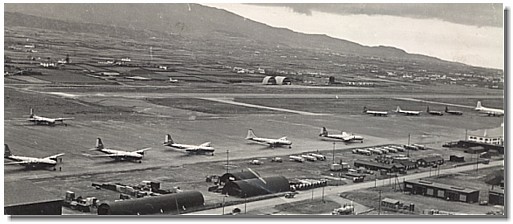 |
We stayed there for the night but when the time came to make a predawn departure for the states,
Carl Gieszl's AJ had some difficulties and was not going to be ready to fly for a while.
I was designated to stay behind with him until his plane was made ready. The rest of the squadron
took off and proceeded to fly direct to Quonset Point, Rhode Island, an estimated eleven hour flight.
Composite Seven (VC-7) Returns Home
The flight of 4 AJ's and 2 P2V's as they flew from the Azores direct to Quanset Point, Rhode Island on October
15, 1952. This photo was taken from the second P2V.

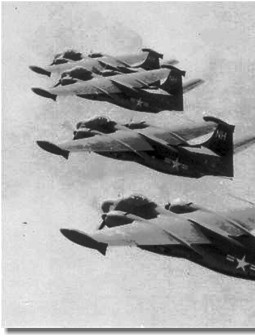 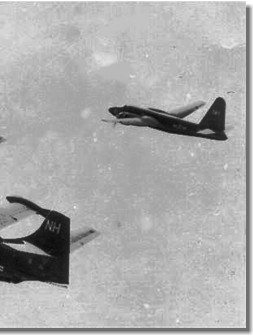 |
Bermuda, Here we come
By the time our two planes were ready, the window of opportunity to go direct to Quonset Point, Rhode
Island was closed so we took advantage of a predicted no wind condition and flew a direct course to Bermuda. The
sea that we flew over was calm like a mill-pond, which was ideal for our enlisted navigators who had never experienced
a long flight like this.
Gieszl had been their instructor and told them that he would help if needed even though both he and
I were the only pilots in our planes and neither one of us had an auto pilot. To make it easier for our young navigators,
they were given the OK to converse with each other via UHF radio.
During the flight when they got ready to shoot a sun line with their sextant, they would both do
it at the same time and then compare notes with each other to give them faith in their own computations. The results
were very good. They were able to calculate our progress along our intended route quite accurately.
Surprise
At one point, we had a little surprise. When we skirted around a little squall line, we came almost
face to face with two waterspouts.
We observed them at rather close range and then went around them.
I had seen a waterspout before; however, this time the light was right which presented an inspiring
sight. Unfortunately there were no cameras aboard.
Click Here for some Off-site Images of Waterspouts
As a farm kid, I had to describe the sight as two mammoth white icesickle radishes hanging down from
the clouds toward the water.
From the surface of the water, a mound of white foam extended upward as if to be reaching for the
icesickle radish. As we watched the two come together, they made a single funnel extending from the surface of
the ocean up to the clouds. It all happened so quickly that it would have been difficult to photograph the event
even if one had been ready for this unusual photo-op in advance. It wasn't safe to turn around for a second look,
so we kept right on picking our way through this unsettled area.
Fishing, any body?
We had selected a route which would take us by way of an ocean station, which was a coast guard ship
stationed at a designated location. As we approached the station and had visual contact, we were unable to make
radio contact.
As we passed over the ship at close range, we noted that there were several small boats in the water
out some distance from the ship obviously fishing. Shortly after passing over them, we received a radio call very
clearly explaining that the fishing was very good and everyone was involved in the excitement.
We alerted them to the possibility of dangerous weather some distance behind us and both went on
about the business at hand.
Land Ho!
About sun-down our young novice navigators were surprised and elated to find Bermuda right where
it was supposed to be according to their charts. They had turned in an excellent performance as navigators, and
received our complements for a job "very well done".
Flying over 10 ½ hours in one seat using a stick control with no autopilot, was quite demanding
of us pilots. Carl and I both had a case of "TB" as we "waddled" away from our planes and started
looking for a place for the whole crew to eat and sleep.
After refueling (only our main and wing-tip tanks) and getting some sleep, we took off for Norfolk.
This last 3.4 hour flight was a breeze. Our young navigators enjoyed this part as they did not have to do much
navigating. How could they mess a big target like the coast of North America?
We arrived at Norfolk just shortly after the other guys in the squadron, who had come by way of Quonset
Point, Rhode Island. They were still parking their planes inside the chain link fenced-in security compound when
we arrived at Breezy Point. We saw our family on the outside but after we entered the compound, the gates were
closed behind us.
It took a little time for me to park the plane and get back out to the entrance to the compound to
see Bonnie and the boys and helped them gain entrance. With Bonnie's impatience, the guard said he was afraid that
the woman was going to tear down the chain link fence while waiting. (A Navy man and his family are always glad
to get back together again after a long time at sea) and this was no exception. The boys had grown and changed
considerably while their dad was away.
Mother Bonnie and the three Pahl boys at home at St Dennis
St. in Norfolk, Va. L-R Randy, Dale on his mother's lap and Neel.- Spring 1952.

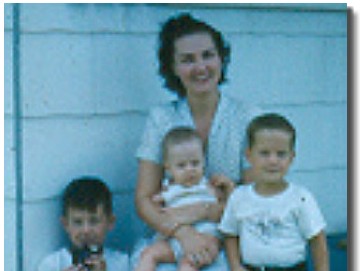
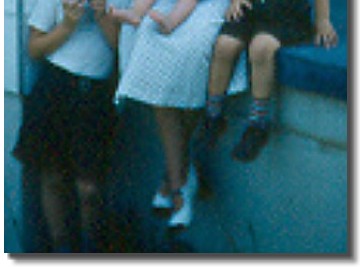 |
Three Pahl boys at St. Dennis St., April 1952. L-R Randy,
Dale and Neel.

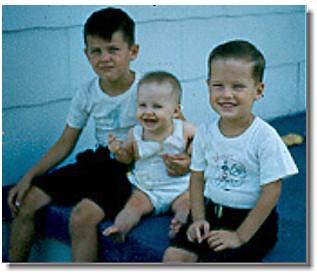 |
Two Pahl boys get cooled off in steel dish pans in garage
at home, St Dennis St. in Norfolk summer '52 L-R-Neel and Dale.

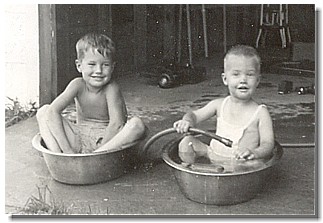 |
Randy, Hersch Pahl`s oldest son,trying out his new Rudge Bicycle
his daddy had purchased in Gibraltar and brought back in his AJ from Port Lyautey. October 1952


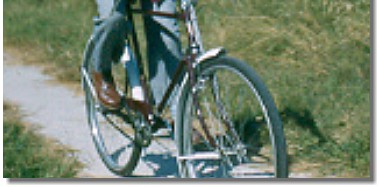 |
The three Pahl boys showing how much they have grown during
the time their daddy was away. L-R:- Randy 7, Neel 4 and Dale 2. Dale is pointing at the photographer, his dad.

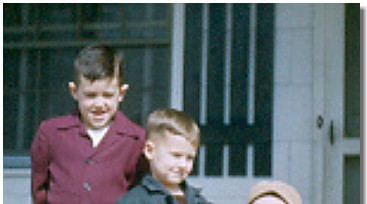
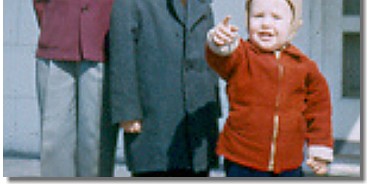 |
Hersch holding Dale, his two year old son, who seems to be
saying "My Daddy come home", which is a fitting climax to this VC-7 Redeployment story.

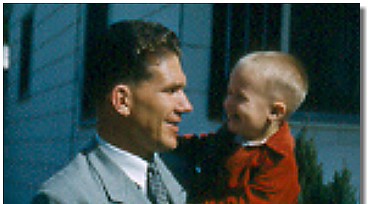
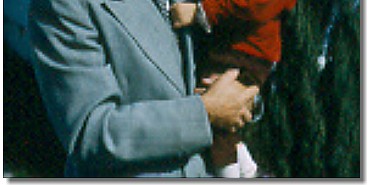 |
The End
- Hersch Pahl
|